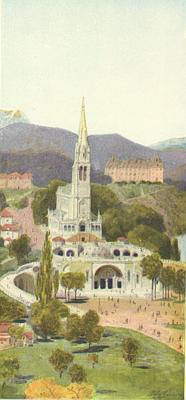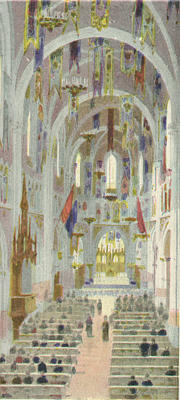
Notre Dame's Grotto / by Dorothy V. Corson

The Hesburgh Library database listed the earliest book about Bernadette, the English version of the French book, Our Lady Of Lourdes, written during her lifetime by Henri Lasserre,(234) her official historian. He wrote about people who witnessed the apparitions and were still alive to be interviewed.Church of the Holy Rosary -- Lourdes 

The church of the Holy Rosary at Lourdes consists of an upper and a lower church quite distinct and necessitating distinct descriptions. The lower church, usually called the Church of the Grotto, is built just below the apse of the basilica and was blasted out of the solid rock. Thus it may be said that the Almighty himself not only laid the foundations of the Church of the Grotto but even raised its walls; the work of man has been merely to carry away the debris. It has no windows, light being admitted through a cupola, and not a single pillar supports the roof and arch; it reminds one of the subterranean vaulted chapels so common in old cathedrals.
The glory of the basilica, however, is the interior of the upper Gothic church, where all the great celebrations of feasts are held. Simple in its design it owes all its splendor to the beauty of its decorations. There are magnificent silken banners woven in every country and in every clime testifying to the gratitude of thousands of pilgrims, while ensigns of the great powers droop in a semicircle around the sanctuary, the Stars and Stripes being conspicuous in the foreground. The magnificent blaze of color produces an effect which description can hardly exaggerate. The walls of the church and the long corridors of the crypt are covered with marble tablets commemorating cures and other favors attained through the intercession of Our Lady at her world-famed Grotto.
Among the many lights which are burning before the high altar is one whose flame is never extinguished. It was called the 'lamp of Ireland' because its anonymous donor was a native of the 'ever-faithful isle;' and there it will burn as long as the church stands in that far away valley of the Pyrenees, symbol of a Faith that never dies.
Stranger and more distinctive signs and symbols are those laid down by repentant sinners at the feet of the Virgin, so that the whole world may see that there have lived strong men who have put away those things hurtful to their spiritual life and growth. There is a battered bronze medal, the Victoria Cross for which thousands of England's sons have died; there a grand cordon of the Legion of Honor; there are swords that are now sheathed and left to rust in this court of peace. There, most magnificent and singular of all, is a strangely shaped miniature in a jeweled case closed forever to the world; the face perhaps of some darling sin or unholy desire.
Surely the human heart is here naked in all its weakness, superb in all its strength!
Although there have been a great many pilgrimages at Lourdes -- notably the Festival of the Banners in 1872, and the English pilgrimages of 1883 -- when all France assembled to implore Mary's intercession for their stricken land, nevertheless there is no special history of the pilgrimages to the Grotto chiefly for the reason that the greatest cures have been wrought in obscurity and quiet and upon those of the humblest origin. God loves to work in silence and in His own good time, acting not when the world is on tiptoe for the event but when the world is asleep or absorbed in trivialities. The population in the mountains and valleys in the neighborhood form the most constant train of visitors, but the pilgrimage is also made by thousands every year from all parts of France, Belgium, Spain and Germany, by many from England, Russia and America, and even by pilgrims from the far east, eager to see the spot touched by the feet of the Virgin and to implore her intercession in their earthly and spiritual needs.
Above the main entrance to the basilica, let into the white stone of the facade, is a large enamel portrait of Pope Pius IX, who proclaimed the dogma of the Immaculate Conception.
It seems fitting that the most ardent champion of Our Lady should have a place of honor in her church, and significant truly that here the peasant girl Bernadette and the pontiff of the universal Church, the genial Pio Nono, are side by side, all earthly distinctions merged and lost in their one title -- children of our Blessed Mother.
__________ 'Rich men and nobles gave their gold and silver, and delicately-nurtured ladies spent night and day in embroidering banners which cities, and towns and rural parishes unanimously agreed to send with their delegates to Lourdes, to be first laid at Mary's feet, and then suspended like so many trophies from the vaulted roof of the church of Massabielle. Men and woman of every rank and station, and from every part of France, assembled with immense enthusiasm and kept up the festival for several successive days. On Sunday morning High Mass was celebrated on a magnificent altar erected in the vast meadows below the grotto, and the bishops of France pronounced their own benediction and that of the sovereign pontiff upon the immense hosts of pilgrims. It was impossible not to feel as if France herself were actually present there, kneeling penitent and forgiven at the feet of her Creator.'